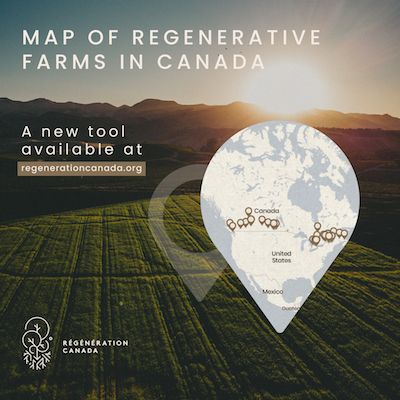By Jade Heilman, Project Manager at Regeneration Canada
In February of 2021, Regeneration Canada proudly launched its Interactive Map of Regenerative Farms in Canada with the mission to promote soil regeneration across the country to help mitigate climate change, increase food security, return biodiversity, improve water cycles, and generally promote the health of Canadians and the ecosystems they rely on.
While awareness of regenerative agriculture is mounting, widespread adoption remains inhibited. Consumers are still unclear about how to promote regenerative agriculture despite increasing recognition of its benefits both to the environment and their personal well-being. Willing farmers often lack the resources or tools to transition, unsure how to start or what techniques will work for their specific conditions. So far, a repertoire of the practices being employed has been lacking, as have inspirational success stories.
Regeneration Canada’s farmer-centred map addresses these barriers by informing, connecting, and mobilizing Canadians around soil health. By showcasing success stories of innovative farmers across Canada, the map offers tangible examples of diverse regenerative farming systems serving as models and inspiration for farmers, while raising awareness of—thus increasing demand for—regenerative products. The map allows farmers to find each other and facilitates peer-to-peer learning. Farmers can search by proximity, practices used, or types of farms, allowing them to find peers overcoming similar barriers. The map also links farmers to consumers. It facilitates access to regenerative products, enabling regenerative farmers to gain visibility and enhance their profitability by allowing consumers to financially support the practices important to them. Consumers can search by products sold, proximity, practices, and farm certifications. Lastly, while gathering a broad network of innovative farmers, the map facilitates connections with agronomists, researchers, labourers, funders and other stakeholders, putting them in touch with the resources they need to accelerate their adoption of regenerative practices and measure their success.
Any farmer using regenerative farming practices in Canada is eligible to be featured on the map. Regenerative agriculture is a continuous process intending to improve soil health, rather than a static set of practices or outcomes, which is why the map aims to remain inclusive. Farm-map profiles are case studies of each farmer’s personal regenerative journey and feature an overview of the practices employed on their farm and improvements they have so far observed on this journey.
Since soil health, like water, traverses socio-political boundaries, connecting the land and its people, Regeneration Canada consciously omitted political borders, replacing them with waterways to remind us that soil and water are inextricably linked. Water gives life to soil, and soil gives structure to water. Likewise, in recognition of the fact that Indigenous people have been stewarding these lands since time immemorial and that many regenerative practices are grounded in Indigenous stewardship customs, Regeneration Canada included Native-Land.ca’s Indigenous Territories as a map layer and entry point for education about this rich regional history across the country.
You can help the map grow by signing up your regenerative farm to be featured, recommending a farm practicing regenerative agriculture, or sharing the Interactive Map of Regenerative Farms with your network.

